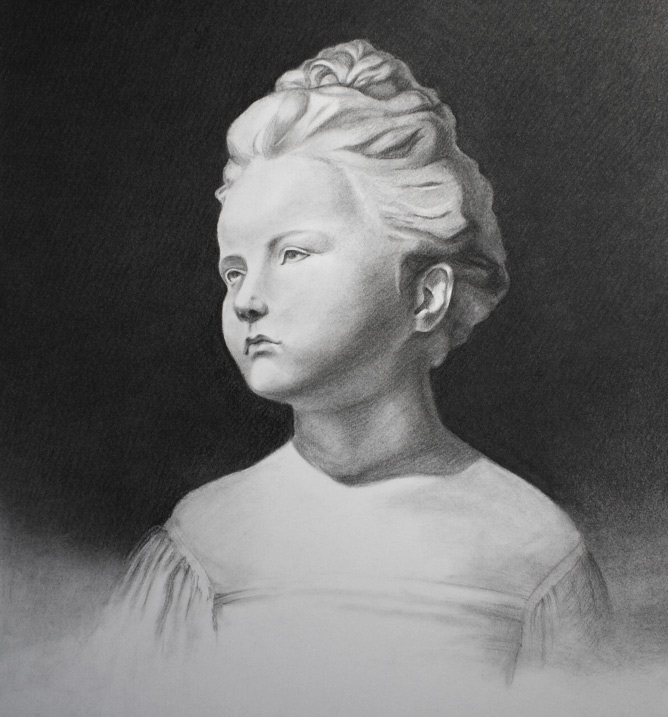How to Draw Girls – The Girl’s Portrait in Charcoal
In this video lesson, you will discover how to draw girls. This “How to Draw Girls” video presents the process of creating the Girl’s portrait in Charcoal.
Enroll in the Drawing Academy Course
Pay once - Enjoy forever!
Only $297
How to Draw Girls
This drawing is based on the plaster cast of a little girl by Alfred Drury. The plaster model was completed in 1897, and thereafter was used for making other versions both in bronze and in marble. The little girl, dressed in Renaissance-style costume, is Gracie Doncaster, the daughter of one of the artist’s friends.
The portrait is very naturalistic, and corresponds with 15th-century Italian art. The plaster bust became an icon of the so-called “New Sculpture” movement in Britain; and it is now exhibited in the Victoria and Albert Museum, London.

When it comes to the first steps of the “How to Draw Girls” video lesson, we begin the drawing with a pencil. First, the overall head proportions are drawn – the virtual vertical line that goes through the middle of the face, the horizontal lines of the eyes, eyebrows, nose, mouth, and the contours of the head.
The girl’s head is slightly tilted away from the viewer, and turned to the left.
At this stage of the “How to Draw Girls” lesson, it is quite important to get the drawing’s proportions right. If you feel that you need to make some corrections, and fine-tune these very important lines, this is the time to do so. Many students make the mistake of not paying enough attention to this initial step, and thereafter face the difficulties of correcting the head’s proportions when the drawing is half done, or almost completed.
Initial pencil lines in the “How to Draw Girls” video are approximated, so they look like a series of straight strokes rather than being curved with precision. Curved lines will eventually emerge, later on, when working on the shape of the drawing.

The rules of linear geometrical construction of the human head are applied here. You may refer, once again, to the corresponding video lessons describing what the head’s proportions are, and how perspective influences the linear drawing.
The drawing is intended to be in charcoal; however, for the initial sketch, we will be using a pencil. This combination of mediums was commonly used by the old masters. There are many drawings by Leonardo da Vinci, Raphael, Michelangelo and other great artists, which have a preparatory sketch by stylus, or in silver point, and are finished in red or black chalks.
During the initial sketch, we fine-tune the linear construction of the drawing, and working on the face details – the eyes, nose, ears, and mouth. There is an old and very good rule describing how to draw smaller features: “when drawing an eye look on the ear”. This rule shows the importance of drawing details, not in isolation, but always comparing their shape, size, and position to other features.
After the rough sketch is done in a series of straight lines, you may wish to smooth these lines with more precise curves, and erase unwanted lines to keep the drawing clean and clear.
Charcoal Drawing
For the charcoal drawing process presented in this “How to Draw Girls” video lesson, we will be using ready-made Winsor & Newton charcoal sticks, which are available in any art supply store. Charcoal sticks are also manufactured by Burton Holt, Daler-Rowney, Faber-Castel, Grumbacher, Holbein and Koh-I-Noor.
Charcoal for drawing comes in several different forms – it can be purchased as natural sticks, compressed pencils, or even powder.
Charcoal pencils are available from Berol, Conte, Daler-Rowney, Eberhard-Faber, General, Grumbacher, and Koh-I-Noor Hardtmuth.
The charcoal is usually made of willow; however, many artists find home-made birch charcoal very suitable for drawing. Charcoal is produced by firing trees’ twigs at high temperatures in airtight containers. The thermal treatment carbonises the wood without burning it to ashes. The natural charcoal is quite fragile and messy to use; so you may find that working with compressed charcoal, or charcoal pencils, suits you better.
Charcoal is available in the range from 2H to 2B; charcoal pencils come in three grades: soft, medium, and hard.
Charcoal is quite a “forgiving” medium. It’s easy to apply and easy to erase.
We will start by outlining the highest contrast line between the background, and the girl’s forehead and right cheek. The darkest areas of the girls face are indicated first, i.e. the shadows near the eyes, and under the nose and mouth. Shadows are sketched quite generally, without small details.
It is important to keep values of tones right from the very beginning. Continually compare the darkness of shadows and mid-tones with each other. Keep the tonal values in the drawing relative to each other. There’s no need to draw shadows, at this initial stage, in full strength. All tones of the drawing will gradually reach their true values; and are made darker as you continue with the drawing.
It is not advisable to completely finish one particular area of the drawing and then work on the rest. Instead, try to keep the drawing looking as complete as possible at any time. Here’s a good test – if you stop at any given moment on your artwork, would it look (possibly not finished) but completed as intended by the artist?





Comments are closed.